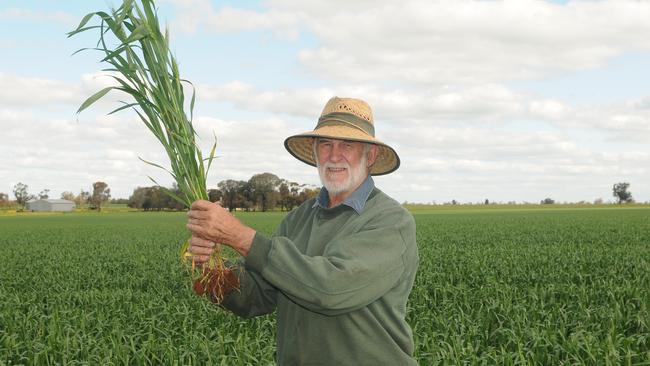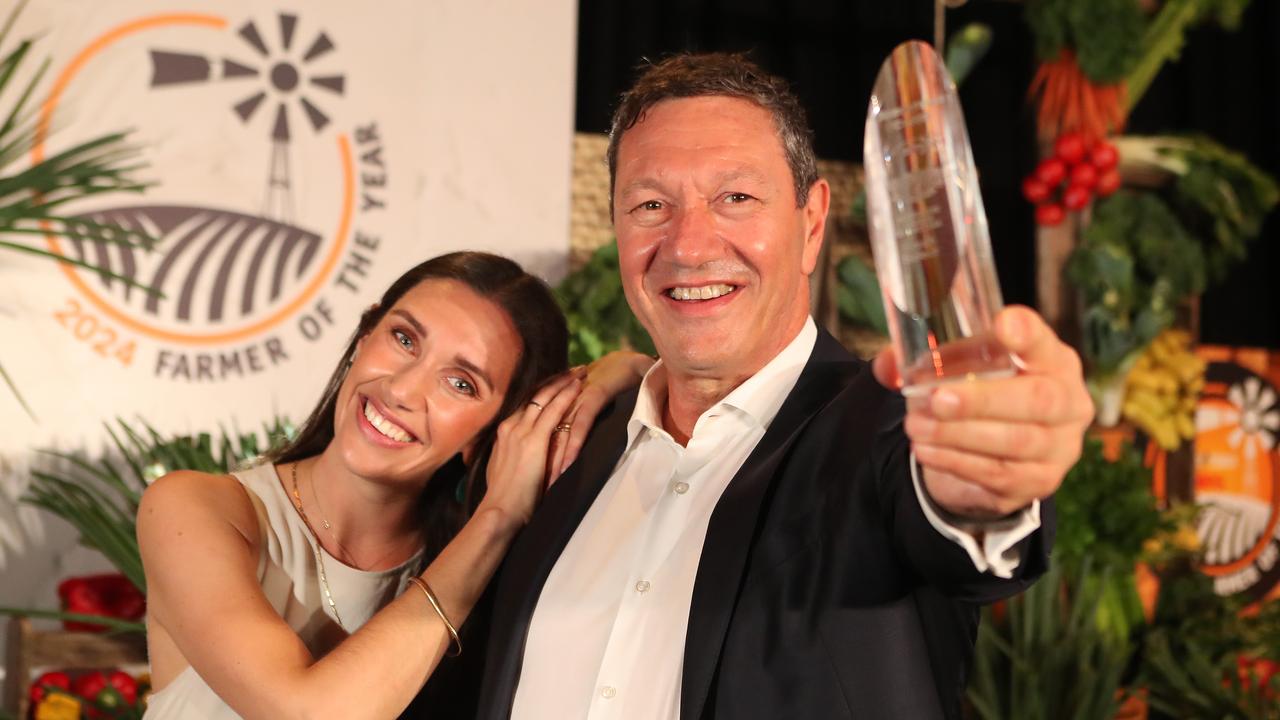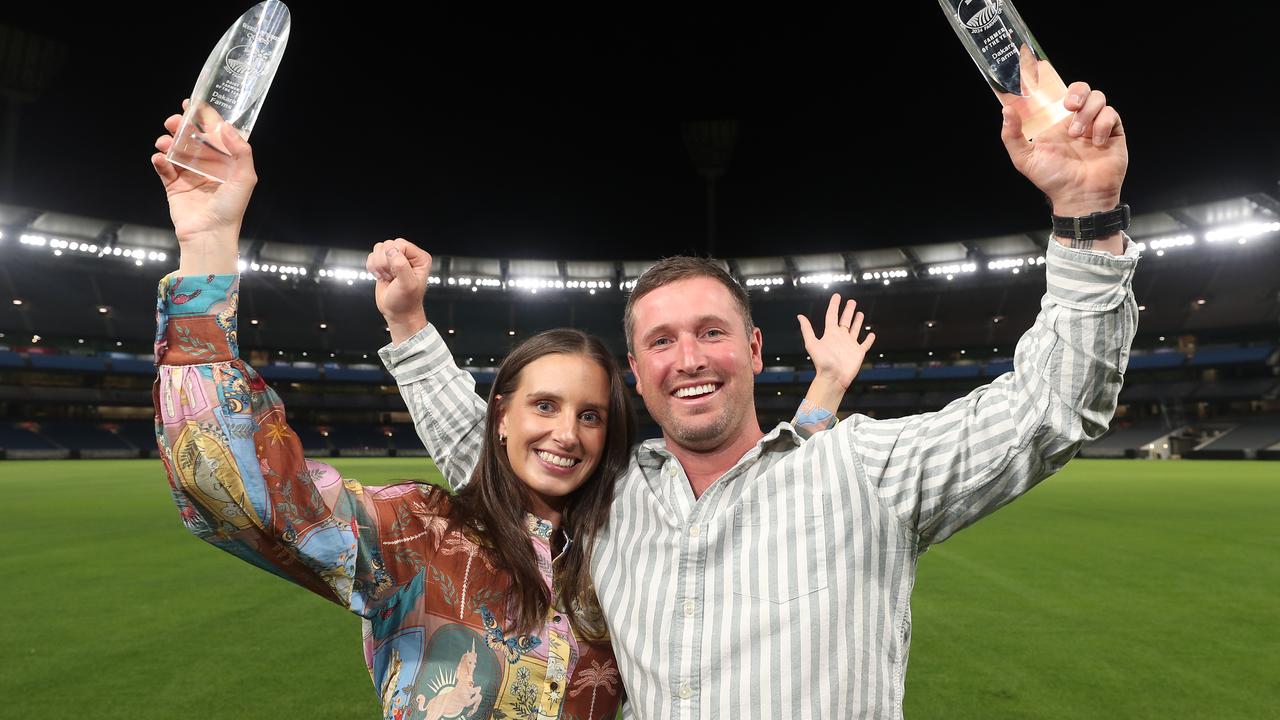Urana NSW farmers Alan and Marea Urquhart hope for a bumper harvest
STANDING in a wheat crop on his NSW Riverina farm, Alan Urquhart pauses briefly to reflect on a season full of promise.

STANDING in a wheat crop on his NSW Riverina farm, Alan Urquhart pauses briefly to reflect on a season full of promise.
“This year has been fantastic as far as rain goes,” he says. “It has all come at the right time. (The crops are) as good as what we’ve ever had.”
Alan, his wife, Marea, their son, Jamie, and his wife, Alana, run a 7500ha mixed crops and sheep business north of Urana. Like many farmers in southern NSW, they are just weeks away from the start of what is shaping up as a bumper harvest, buoyed by good winter rain that eluded much of western Victoria’s wheat belt.
Should the season prevail, the Urquharts are banking on yields of 4-5 tonnes/ha for their wheat and barley and 2 tonnes/ha for lupins and canola.
Add to that solid returns for their sheepmeat, prime lambs and wool, and Alan says there’s plenty of reason to be optimistic.
IN THE MIX
THE Urquharts farm their home property, Bellevue, bought in 1981, as well as a section of Alan’s original farm 15km away and a nearby leased property. Bellevue receives about 400mm of rain annually and to the end of August recorded 300mm.
Alan said the rainfall average was slightly less than nearby Lockhart “where you pick up another inch (25mm)” and Milbrulong “where you pick up another few inches”.
Soils are red loam that boast a pH of about 4.8, meaning lime needs to be applied at times. The business is weighted towards crops.
This year they have 1830ha planted — 120ha of canola (“we cut back this year because we got burnt last year”), 520ha of wheat, 960ha of barley and 230ha of lupins. A further 220ha of vetch is grown as a break crop — 40ha will be harvested for seed, with the remainder, along with some paddocks of wedgetail wheat and brassica, used to finish sucker lambs.
They run 1500 dual-purpose Dohne ewes, 800 of which are joined to Dohnes in a self-replacing flock with 700 mated to Poll Dorsets to produce terminal lambs.
BARLEY SUITED
A BIT more barley has been added into the Urquharts’ cropping program this year, at the expense of wheat.
“Normally we’d be about half-half, but we found that with our dry finishes barley really does well. We yielded 3 tonnes of barley on a dry year last year and our wheat was less than 2 tonnes/ha.” Alan said.
The program usually kicks off with vetch, sometimes as early as March “if we get an early rain”. Wedgetail wheat and brassicas can also be sown earlier should the season allow.
The bulk gets under way about April 20, “always hopefully with rain”, with canola followed by lupins, barley and wheat. Alan said an early start also helped minimise any effects a late spring frost might have on the crops.
Pre-sowing, Roundup is used should there be weed issues, plus herbicides such as Treflan, Diuron and Box of Gold. The seed goes in with MAP fertiliser at a rate of about 60kg/ha, treated with Impact to help curb outbreaks of rust, while urea is spread according to the season.
“Depending on the paddock and the crop, you might put from 60 to 100kg/ha,” Alan said,
SIMPLE SILO
ALAN said harvest, “as a rule”, usually started during the second week of November. Last year it was earlier, in October.
“We can usually knock it over in a month,” Alan said.
While the Urquharts cart what grain they can, a contractor from Gerogery, north of Albury, harvests the crops.
The Urquharts sell some barley at harvest before storing the remainder in on-farm silo bags to be sold at ideally better prices the following winter. Alan said when they sold some barley in May last year, they achieved a $70 a tonne premium as feed grains were in short supply. He said the silo bags, which hold 200 tonnes of barley, represented “good value”. “It costs $10 a tonne, with the cost of the bags and in and out, but you don’t have to freight it from your farm.”
Some wheat was also stored on farm after last harvest and sold for a January-February delivery. The Urquharts also have extra storage silos for lupins — “weevils don’t worry them” — allowing them to sell at market highs.

DOHNE DEAL
IN 2004, the Urquharts switched from Merinos, which they’d farmed since the 1980s, to the South African dual-purpose Dohne primarily because their country was not suited to growing out Merino wethers.
“Merino wether lambs need to walk out on the big stations to really do well; the Dohnes are suited more to this area.”
They bought rams from Uardry and Macquarie Dohne studs at Hay and Dubbo and joined them with Merino ewes.
Alan said the first couple of crosses were good but they then “tapered off in the wool and we’re trying to get the wool back a bit” with the help of classer Bill Mildren.
Ewes are joined for six weeks in November at a rate of one ram to 70-80 ewes. “Years ago we used to put in one to 50 and then we started tapering off on our rams and we went a little bit higher and we were getting more lambs. Depending on mob sizes, they can go out to one to 80, and they’ve no problem getting them in lamb.”
GROWING FLOCK
ALAN said the Dohnes produced good lambing rates of up to 120 per cent “without any trouble”. “And that’s with autumn-drop lambs, which is pretty good. (With the pure Merinos) you were only looking at about 90 (per cent), so there’s a fair pick up. We have dropped back in our wool cut by a couple of kilograms, but we’re getting more lambs.”
Wool cuts are now about 6kg at shearing, which occurs in August, with wool offered in Melbourne during September.
Sheep are generally run on vetch, which is then green manured and goes back into the crop rotation the next year, brassica and wedgetail wheat. If grain prices are right “and your costs aren’t going to be too high” they sometimes lot feed their Dohne wether lambs for eight weeks.
Dohne wether lambs are usually sold through the Wagga Wagga saleyards at 10 months of age, having been shorn in December.
Most terminal lambs are sold as suckers. Last year they were all sold over the hooks. One recent draft of 400 suckers fetched $161.40, dressing out at 25.5kg.
Looking ahead, the Urquharts plan to increase ewe numbers by “another couple of hundred if we can” and are on the lookout for an extra 25mm of rain to finish the crops.


